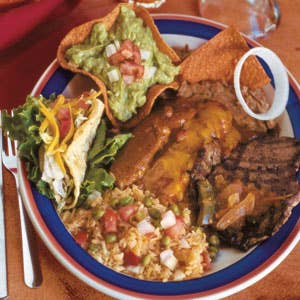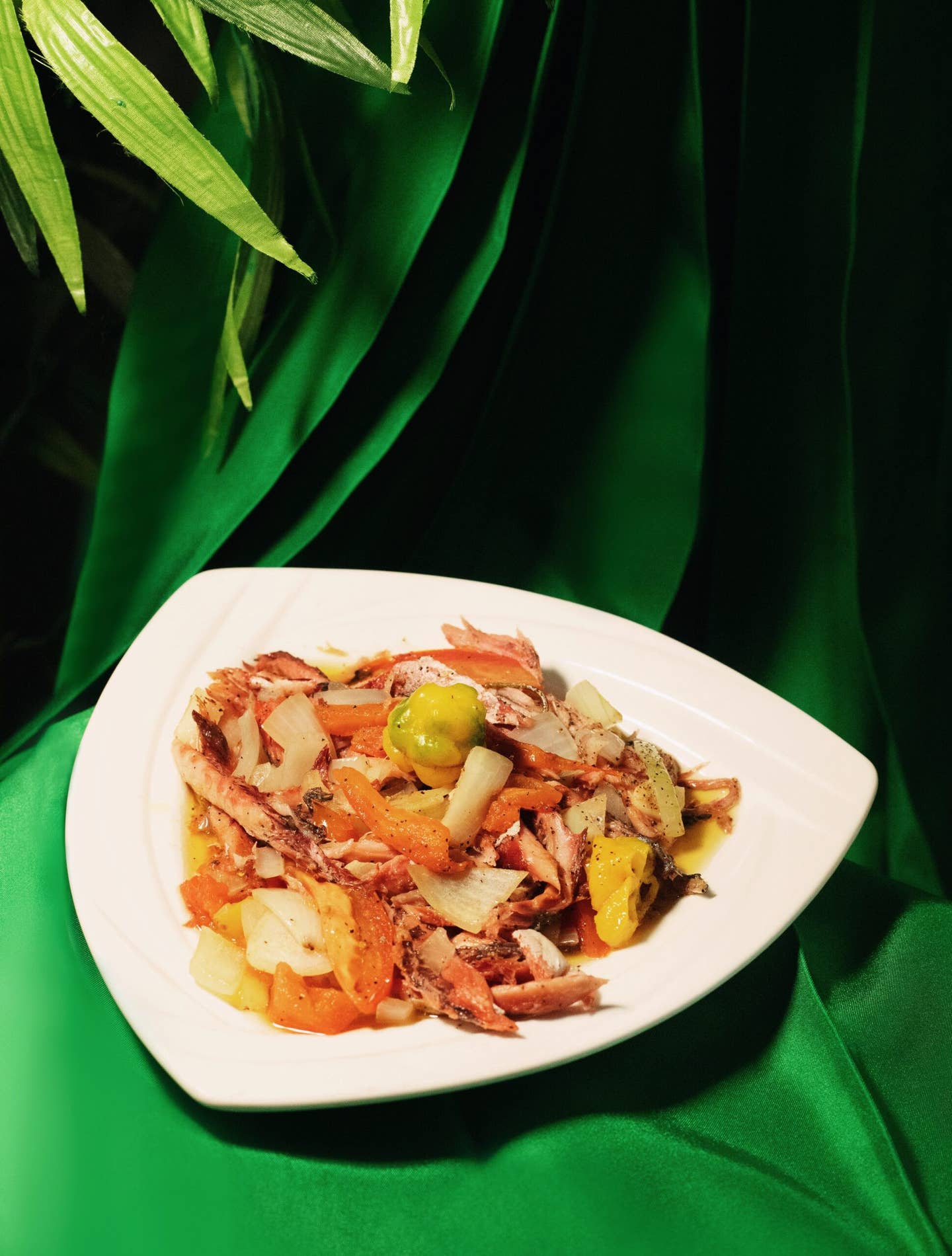
Capital of Tex-Mex
It's nine a.m. at Mi Tierra, and _todo _San Antonio is there—businessmen in neckties talking shop, overall-clad workers on a breakfast break, extended families chattering away while baby naps in a fleece-lined carrier, out-of-towners still bleary-eyed from too many margaritas on the River Walk last night—digging into steaming bowls of menudo, or working on enormous combination platters of huevos rancheros, refried beans, fried potatoes, and pork chops or bacon. Someone is eating beef enchiladas topped with fried eggs. There's not a bowl of granola or a grapefruit half in sight.
Mi Tierra is a noisy, good-smelling, visually dizzying place, hung with thousands of Christmas lights. It's also one of the oldest, biggest, and best Tex-Mex restaurants in San Antonio, a city that can lay claim to being the Tex-Mex capital of the world.
Sometimes called "the northernmost city in Mexico" (the border is only 150 miles away), San Antonio may be famous as the home of the Alamo and of a pretty hot professional basketball team—but for centuries it was a cosmopolitan market town, occupying a privileged position along the Camino Real, the Spanish Royal Road linking Mexico City and western Louisiana. The Market Square area of the city, a touristy restaurant-and-shopping complex since the 1970s, had been the site of a thriving food market for almost 250 years when Pete Cortez, a newcomer from Guadalajara, and his San Antonio-born bride, Cruz Llanes, opened the predecessor to Mi Tierra there in 1941.
The market vendors were a varied lot: some of the earliest settlers were Canary Islanders; the fish wholesalers were Lebanese. "My grandfather was very aware of the cuisine of Mexico," says a younger Pete Cortez, grandson of Mi Tierra's founder and one of six third-generation siblings actively involved in the restaurant today, "but in San Antonio he began to adapt his cooking to suit his customers, using the ingredients he found here. In Mexico, you might fill an enchilada with goat cheese and put a chile salsa on it; here you used cheddar and sauced it with brown gravy." Or as Pat Sharpe, the food editor of Texas Monthly, puts it, "Tex-Mex is something of an orphan cuisine. When Texas was part of Mexico, it was like Spain in the Roman Empire—the farthest outpost. People made do with what they could get." That's Tex-Mex in a pecan shell: Mexican form with Texas content.
I grew up eating Tex-Mex food, or something very much like it, in Southern California in the '50s and '60s—dishes inspired by the working-class fare of Mexico (especially northern Mexico), but cooled down and Americanized and expressed through ingredients like ground meat, garlic powder, chili powder, and processed cheese. We didn't call it Tex-Mex, of course (much less "Cal-Mex"); we called it Spanish. "We didn't call it Tex-Mex either," says Pat Sharpe, who grew up in Austin around the same time. "We just called it Mexican. It was the food you ate at restaurants where people of Mexican descent cooked for both Mexicans and Americans." The contraction Tex-Mex probably first appeared in the 19th century as an abbreviation on the sides of boxcars on the Texas Mexican Railway; it wasn't applied to food until the 1970s.
With the possible exception of chili, the defining specialty of Tex-Mex cooking, served today in Mexican-inspired restaurants all over the globe, is the combination plate—typically a cheese or ground-beef enchilada with refried beans and "Spanish rice" (a tomatoey concoction unknown in Spain), perhaps with a taco or a tamale on the side. Richard West, writing in Texas Monthly in 1986, traced the origins of the combination plate back to 1887, to the now defunct Old Borunda Cafe in the south Texas town of Marfa. By 1900, when O. M. Farnsworth opened his seminal Original Mexican Restaurant in San Antonio, the combination plate had become a regional tradition.
For a savory demonstration of the difference between Texas-style cheese enchiladas—the kind you find on most combination plates—and the more authentically Mexican varieties, go easy on the addictive sour cream-topped nachos at San Antonio's popular Los Barrios and save room for the "classic enchilada assortment," which is both a dish of heroic proportions and an educational experience. The assortment includes a chicken-filled tortilla in tomato-and-chile ranchera sauce, another one cloaked in mole, and a cheese-filled enchilada in green tomatillo sauce (excellent examples of regional Mexican cooking as interpreted in the American Southwest); an enchilada mexicana, filled with crumbly queso blanco and topped with a slightly bitter roasted ancho chile sauce, pure interior Mexico, wonderfully evocative and delicious; and a Tex-Mex version, a soft, warm conglomeration of oozy processed yellow cheese, faintly chewy corn tortilla, and rich chili-powder reddish-orange gravy. Like all the best Tex-Mex fare, it's the kind of dish you just sort of sink into; an indulgent, no-excuses guilty pleasure.
The big star of Tex-Mex cooking in the late 20th century—and the only example of the genre not likely to send cardiologists running screaming from the room—is fajitas. Fajita—the diminutive of faja, meaning sash or girdle—is the name applied by south Texas butchers to the diaphragm muscle of the steer, better known as skirt steak. (Real fajitas are always made with skirt steak—not with chicken, shrimp, or, Lord help us, portobello mushrooms!) The celebrated original Ninfa's restaurant in Houston claims to have introduced the dish in restaurants in 1973. But according to Texas A&M animal science lecturer Homero Recio, who has studied the origins of fajitas, that honor belongs to the Round-Up Restaurant in Pharr, a few miles from the border in far south Texas, whose fajitas first appeared in 1969. The Round-Up may also have been the first place to serve the meat on a sizzling platter (the accompanying onions, peppers, and tomatoes were added later), though that distinction is claimed by others, too, among them the Cortez family, who opened a place called La Margarita a block from Mi Tierra in 1981, with fajitas as the featured item. The fajitas at La Margarita are flawless, in any case—tender and flavorful meat with just the right proportion of vegetables.
Other Tex-Mex basics include tortilla chips and salsa, all but unknown (as a combination) in Mexico; nachos (apparently invented by Ignacio "Nacho" Anaya, chef at the Victory Club in the Mexican border town of Piedras Negras, in the 1940s); chile con queso (gooey melted cheese, traditionally based on Velveeta, and not to be confused with the more genuinely cheesy and authentic preparation known as queso flameado or queso fundido); crisp-shell tacos, especially those filled with ground beef, chopped lettuce and tomatoes, and shredded cheese; and the signature dish of San Antonio Tex-Mex: puffy tacos.
These are raw corn tortillas tossed directly into hot cooking oil, where they puff up, growing light and crumbly, instead of just crisping (they're a bit like those edible fried flour-tortilla bowls in which chain restaurants serve taco salads). Puffy tacos appear on menus all over San Antonio, from homey little places like Lucy's Kitchen, where they're very good, to the popular Torres Taco Haven, where they're fine—but not as good as the chicken-and-cabbage "Ralphie's special," in crisped but not quite puffy corn tortillas.
The puffy tacos are predictably good, too, at Henry's Puffy Tacos, a big, friendly place in an oversize strip mall, furnished with memorabilia of noted regional musicians, athletes, and the like (Tejano star David Lee Garza's first accordion; Oscar de la Hoya's boxing gloves). Even better there, however, is a monumental piece of Tex-Mex culinary architecture called the enchurrito (not to be confused with Taco Bell's famed Enchirito)—an immense burrito stuffed with stewed beef and refried beans and topped with brown gravy and cheese, all of it melting together into one glorious, richly flavored mass. The Lopez family, which runs Henry's, once lived in Buena Park, California, near Disneyland—prime burrito territory. "I used to eat a lot of burritos and a lot of enchiladas," Henry's manager Rick Lopez explains, "and loved both, so I combined the two."
As for puffy tacos, Rick Lopez thinks they may have been developed by his uncle Ray at his place, Ray's Drive Inn. Ray died in 1998, but the Drive Inn—an engagingly funky cafe whose interior is enhanced with everything from old Coke machines to a wall full of Mexican religious icons—is now under the ownership of his brother Art. Art serves the best puffy tacos I found, with crisp, light, flavorful shells and a picadillo filling that is perfectly seasoned and not the least bit greasy. "I don't say we invented puffy tacos," Art tells me, "but we did invent the name. I have a trademark on it. One of these days, I'm going to get an attorney in San Antonio and stop everybody else from using it."
Keep Reading
Continue to Next Story










